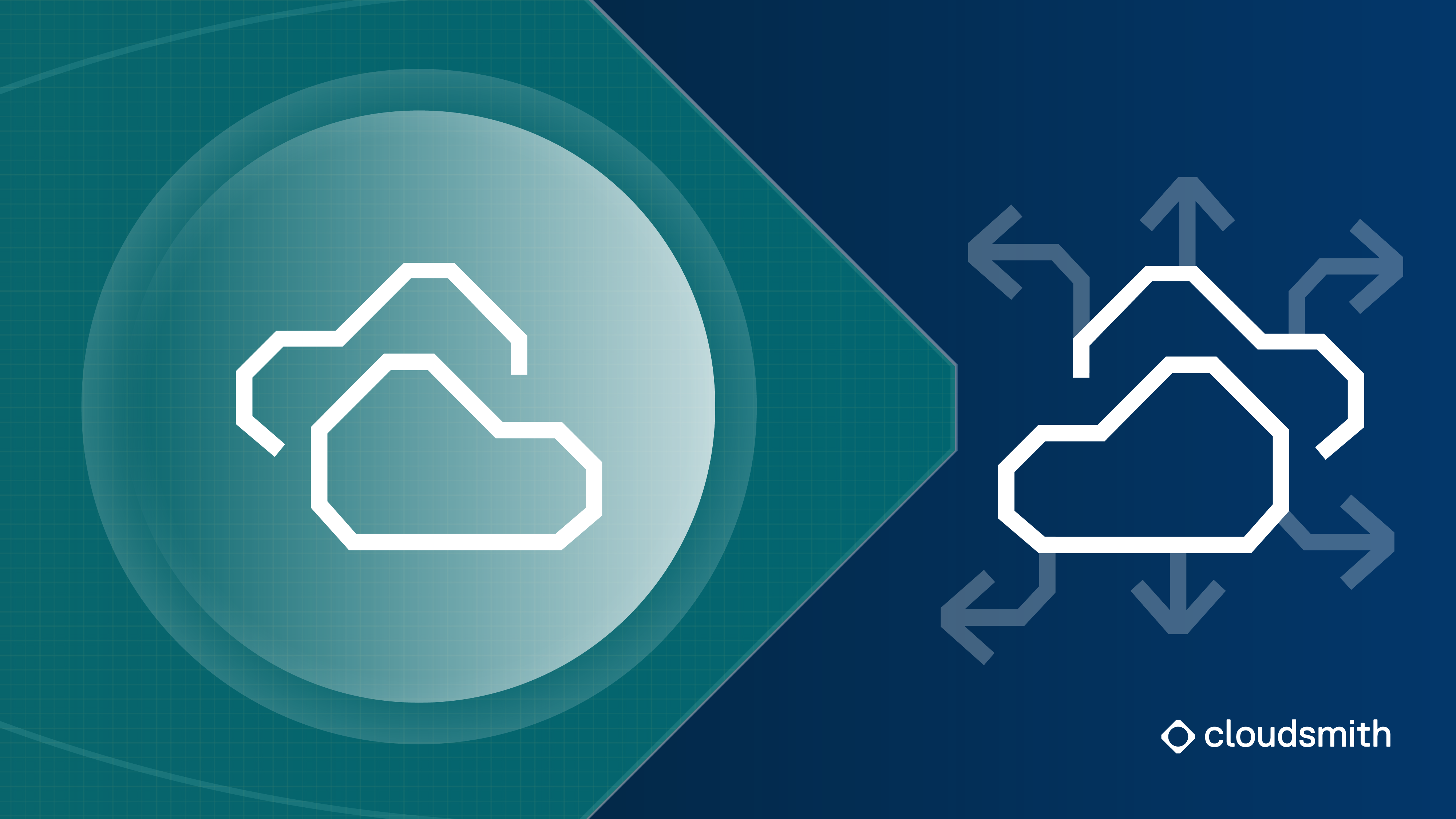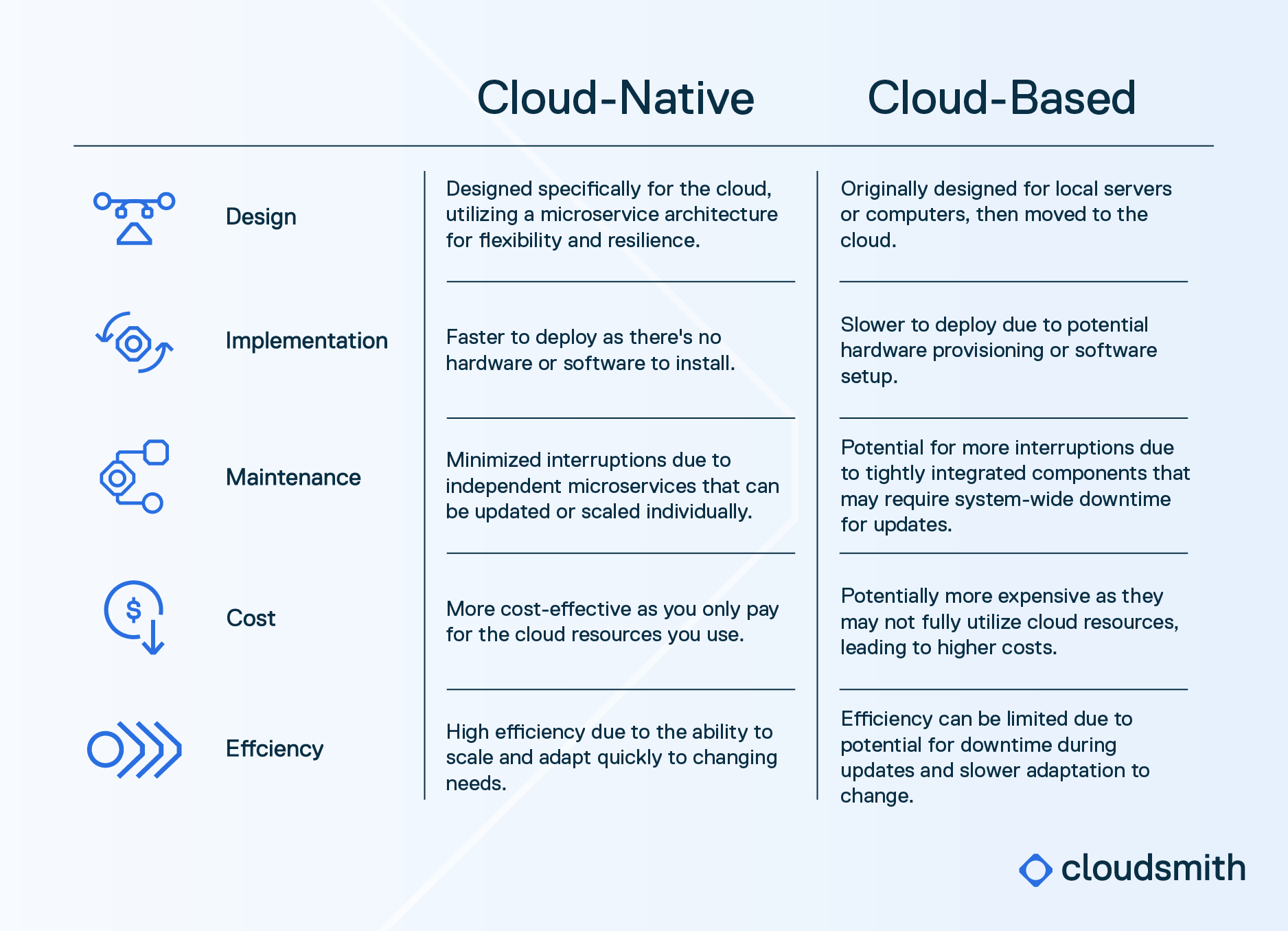Cloud-Based vs Cloud-Native: What’s the difference?
Get to know the differences between cloud-native and cloud-based applications, their benefits, and why a cloud-native tool like Cloudsmith is a game-changer for efficient and secure software artifact management.

The term 'cloud' has become a buzzword in the tech industry, often used interchangeably to describe anything from online storage to complex computing services. But what does it really mean? And more importantly, what is cloud-native, and how does it differ from cloud-based?
“The Cloud” is a concept that has certainly revolutionized the way we store, manage, and interact with data. But as with any technological advancement, the cloud comes with its own set of terminologies that can often be confusing. Two such terms that often cause a confusion are 'cloud-native' and 'cloud-based'. While they might sound similar, they represent different approaches to using the cloud. Understanding these differences is crucial for businesses aiming to leverage the cloud effectively.
In this blog post, we'll look at the differences between cloud-native and cloud-based applications, explore their pros and cons, and help you understand which approach might be the best fit for your business. We'll also introduce you to Cloudsmith (that’s us!) a cloud-native tool designed to streamline your software supply chain management, giving you complete control over how you distribute software.
Understanding Cloud Applications: A Tale of Two Clouds
What is Cloud-Based?
Cloud-based applications are akin to a well-loved, well-used piece of furniture that you've decided to move into a new house. These applications were originally designed to run on local servers or personal computers but have been relocated to the cloud. While this move offers the benefits of the cloud, such as remote access and reduced physical infrastructure, it also brings along some of the old furniture's quirks.
Cloud-based applications tend to be tightly integrated, meaning their components are interconnected and dependent on each other. This integration can be a strength, providing consistency and reliability. However, it also means that when one part of the application needs an upgrade or encounters an issue, the entire system might need to be taken offline. This can lead to downtime, which can disrupt operations and impact productivity.
What is Cloud-Native?
Cloud-native applications are like a house built from scratch, designed to fit the specific characteristics of its location. These applications are designed specifically for the cloud environment from the get-go. They're built to be flexible, scalable, and resilient, taking full advantage of the cloud's capabilities.
Cloud-native applications often employ a microservice architecture. This means they're composed of small, independent services that work together, much like a well-coordinated sports team. Each player (or service) has a specific role and can operate independently of the others. This independence means that individual parts of a cloud-native application can be updated, scaled, or even taken offline without disrupting the entire system.
Comparing Cloud-Native and Cloud-Based Applications
So what's the difference between cloud-native and cloud-based? It all comes down to design philosophy, implementation strategy, maintenance requirements, and cost efficiency
- Deployment Speed: Cloud-native applications are faster to deploy because there's no need for traditional hardware or software installation.
- Scalability: Microservices allow cloud-native applications to scale seamlessly, whereas cloud-based applications may struggle due to architectural constraints.
- Downtime: Cloud-native apps are built for resiliency, reducing the risk of downtime during updates or outages.
- Cost-Effectiveness: With cloud-native architecture, you only pay for the resources you actually use.
Cloud-based applications, while still offering the benefits of the cloud, can be slower to deploy and more prone to interruptions. Because they weren't originally designed for the cloud, they might not be able to take full advantage of all the cloud's benefits.

The Benefits of Using a Cloud-Native Tool: Introducing Cloudsmith
Enter Cloudsmith, a cloud-native tool, fully managed, universal artifact management platform. Cloudsmith is designed to help you manage your software assets efficiently and securely, giving you complete control over your software supply chain.
Here are some of the key benefits of using cloud-native applications:
- Rapid scalability: Easily scale applications up or down based on demand.
- Faster deployment cycles: Continuous delivery pipelines allow rapid release and updates.
- High availability and resilience: Built-in fault tolerance and self-healing capabilities.
- Reduced operational overhead: Minimal maintenance required with managed services.
- Improved resource utilization: Pay only for the cloud resources you use.
- Enhanced developer productivity: Developers can work independently on microservices.
- Stronger security posture: Frequent updates and centralized control reduce vulnerabilities.
But why is artifact management so important? In the world of software development, an artifact is any file or resource that is produced during the software development process. This could be anything from compiled source code and documentation to test data and final software packages. Managing these artifacts effectively is crucial for maintaining the efficiency, reliability, and security of your software supply chain. It allows you to keep track of the different versions of your software, ensure that your teams are always working with the correct resources, and protect your software from potential security threats.
Cloudsmith provides a centralized platform for managing and distributing software packages. It's like having a dedicated, secure, and efficient delivery service for your software. You can track and control your software assets, ensuring they're delivered quickly and securely. It is flexible, scalable, and resilient, and making it the go-to cloud-native platform for modern software delivery.
As a cloud-native application, Cloudsmith is designed to grow and evolve with your business. It requires no infrastructure management, allowing you to focus on what really matters—building great software. It adapts to your workflows, integrates with your CI/CD pipelines, and scales effortlessly as your needs grow.
Conclusion
Choosing between cloud-native and cloud-based applications often comes down to your specific needs and circumstances. Both have their strengths and can offer significant benefits. But, cloud-native applications like Cloudsmith offer a level of flexibility, scalability, and resilience that's hard to beat. They're designed for the cloud, built to take full advantage of its capabilities, and ready to adapt to your organisation's evolving needs.
If you're looking for a cloud-native tool to help you take control of your software supply chain, look no further. Cloudsmith is built by developers, for developers, and it's ready to support your growth in the cloud era.
Explore the benefits of cloud-native applications today, and see how Cloudsmith can empower your team to move faster, safer, and smarter in the cloud.
Frequently Asked Questions (FAQs)
1. What is the difference between cloud-native and cloud-based?
Cloud-native is built for the cloud from scratch. Cloud-based is migrated to the cloud but was originally designed for on-premises use.
2. What is a cloud-native application?
A cloud-native application is designed specifically for cloud environments, using microservices, containers, and CI/CD for agility and scalability.
3. What are the benefits of cloud-native applications?
They offer faster deployment, high scalability, resilience, cost-efficiency, and better performance in cloud environments.
4. What is a cloud-native tool?
A cloud-native tool, like Cloudsmith, is built to run in the cloud, offering secure, scalable solutions for modern software development.
5. Why choose cloud-native over cloud-based?
Cloud-native apps are more agile, resilient, and cost-efficient. They outperform cloud-based apps in speed, updates, and scalability.
6. Can a cloud-based app become cloud-native?
Yes, through re-architecture. Refactoring into microservices and using cloud-native tools helps modernize cloud-based apps.
7. Are cloud-native platforms secure?
Yes. Cloud-native platforms offer robust security features, continuous updates, and better isolation through containers.
8. Do I need DevOps for cloud-native development?
Yes, DevOps practices like CI/CD are crucial to take full advantage of cloud-native architecture and automation.
Liked this article? Don\'t be selfish (:-), share with others: Tweet

